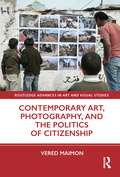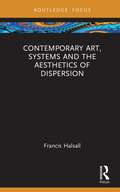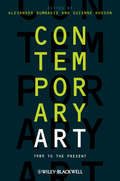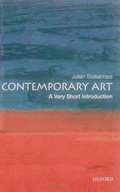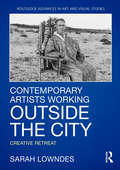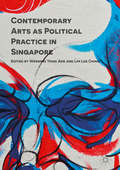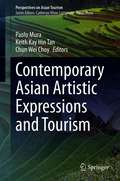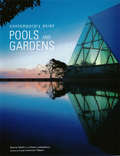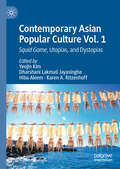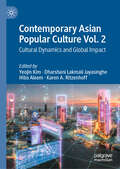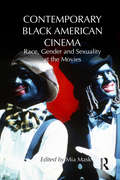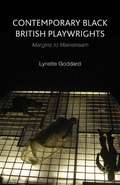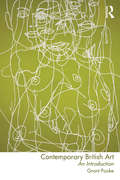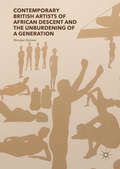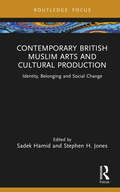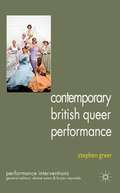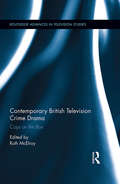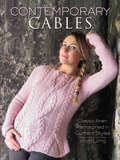- Table View
- List View
Contemporary Art, Photography, and the Politics of Citizenship (Routledge Advances in Art and Visual Studies)
by Vered MaimonThis book analyzes recent artistic and activist projects in order to conceptualize the new roles and goals of a critical theory and practice of art and photography. Vered Maimon argues that current artistic and activist practices are no longer concerned with the “politics of representation” and the critique of the spectacle, but with a “politics of rights” and the performative formation of shared yet highly contested public domains. The book thus offers a critical framework in which to rethink the artistic, the activist, and the political under globalization. The primary focus is on the ways contemporary artists and activists examine political citizenship as a paradox where subjects are struggling to acquire rights whose formulation rests on attributes they allegedly don't have; while the universal political validity of these rights presupposes precisely the abstraction of every form of difference, rights for all. The book will be of interest to scholars working in art history, contemporary art, photography theory, visual culture, cultural studies, critical theory, political theory, human rights, and activism.
Contemporary Art, Systems and the Aesthetics of Dispersion (Routledge Focus on Art History and Visual Studies)
by Francis HalsallUsing five case studies of contemporary art, this book uses ideas of systems and dispersion to understand identity and experience in late capitalism. This book considers five artists who exemplify contemporary art practice: Seth Price; Liam Gillick; Martin Creed; Hito Steyerl; and Theaster Gates. Given the diversity of materials used in art today, once-traditional artistic mediums and practices have become obsolete in describing what artists do today. Francis Halsall argues that, in the face of this obsolescence, the ideas of system and dispersion become very useful in understanding contemporary art. That is, practitioners now can be seen to be using whatever systems of distribution and display are available to them as their creative mediums. The two central arguments are first that any understanding of what art is will always be underwritten by a related view of what a human being is; and second that these both have a particular character in late capitalism or, as is named here, the Age of Dispersion. The book will be of interest to scholars and students working in art history, contemporary art, studio art, and theories of systems and networks.
Contemporary Art: 1989 to the Present
by Alexander DumbadzeAn engaging account of today’s contemporary art world that features original articles by leading international art historians, critics, curators, and artists, introducing varied perspectives on the most important debates and discussions happening around the world. Features a collection of all-new essays, organized around fourteen specific themes, chosen to reflect the latest debates in contemporary art since 1989 Each topic is prefaced by an introduction on current discussions in the field and investigated by three essays, each shedding light on the subject in new and contrasting ways Topics include: globalization, formalism, technology, participation, agency, biennials, activism, fundamentalism, judgment, markets, art schools, and scholarship International in scope, bringing together over forty of the most important voices in the field, including Sofía Hernández Chong Cuy, David Joselit, Michelle Kuo, Raqs Media Collective, and Jan Verwoert A stimulating guide that will encourage polemical interventions and foster critical dialogue among both students and art aficionados
Contemporary Art: A Very Short Introduction
by Julian Stallabrass"Bloodied toy soldiers, gilded shopping carts, and Lego concentration camps. Contemporary art is supposed to be a realm of freedom where artists shock, break taboos, and switch between confronting viewers with works of great profundity and jaw-dropping triviality. But away from shock tactics in the gallery, there are many unanswered questions. What is contemporary about contemporary art? What effect do politics and big business have on art? And who really runs the art world?" "Previously published as Art Incorporated, this controversial and witty Very Short Introduction is an exploration of the global art scene that will change the way you see contemporary art."--BOOK JACKET.
Contemporary Artists Working Outside the City: Creative Retreat (Routledge Advances in Art and Visual Studies)
by Sarah LowndesThis book reflects on the motivations of creative practitioners who have moved out of cities from the mid-1960s onwards to establish creative homesteads. The book focuses on desert exile painter Agnes Martin, radical filmmaker and gardener Derek Jarman, and iconoclastic conceptual artist Chris Burden, detailing their connections to the cities they had left behind (New York, London, Los Angeles). Sarah Lowndes also examines how the rise of digital technologies has made it more possible for artists to live and work outside the major art centers, especially given the rising cost of living in London, Berlin, and New York, focusing on three peripheral creative centers: the seaside town of Hastings, England, the midsized metro of Leipzig, Germany, and post-industrial Detroit, USA.
Contemporary Arts as Political Practice in Singapore
by Wernmei Yong Ade Lim Lee ChingThis pivot examines the contemporary arts as political practice in Singapore. Singapore marked 50 years of Independence in 2015 and this timely collection on the topic of contemporary arts as political practice in Singapore offers critical insight into some of the more controversial talking points that have shaped Singapore's identity as a nation. Focusing on the role played by contemporary arts in shaping Singapore's political landscape, the authors consider how Politics is often perceived as that which limits the flourishing of the arts. Contending that all art is political, and that all art form is a form of political practice, this collections examines ways in which the practice of art in Singapore redraws the boundaries that conventionally separate arts from politics. It critically examines the tenuous relationship between the arts and politics and offers a timely reevaluation of the relationship between the arts and politics. In doing so, this collection opens a dialogue between artistic practice and political practice that reinforces the mutuality of both, rather than their exclusivity and redefines the concept of the political to demonstrate that political involvement is not a simple matter of partisan politics, but has an inherently aesthetic dimension, and aesthetics an inherently political one.
Contemporary Asian Artistic Expressions and Tourism (Perspectives on Asian Tourism)
by Paolo Mura Keith Kay Hin Tan Chun Wei ChoyThis book explores the relationship between tourism/tourists and expressions of contemporary Asian art (for example, artists, objects, intangible artistic productions, digital manifestations, etc) in Asian and non-Asian tourist spaces/experiences.Although the nexus between art and tourism has not been neglected in the literature, work on contemporary art and tourism is lacking, and this is particularly true within the context of non-Western societies. This volume creates a timely counterpoint to the existing dominance of a Western-centric body of knowledge in the area.The book considers how encounters between tourists and expressions of Asian contemporary art may produce possibilities for challenging, re-evaluating or reasserting crystallized frames of understanding and, as such, is of value to a multi-disciplinary audience.
Contemporary Asian Bathrooms
by Luca Invernizzi Tettoni Chami Jotisalikorn Karina ZabihiShot entirely on location, Contemporary Asian Bathrooms presents the newest trends emerging in Asian home design. Gorgeous full color photographs showcase the sexy new look and fantasy appeal of today's bathrooms. Featuring one-of-a-kind indoor and outdoor bathroom designs in 50 luxury homes and hotels across Southeast Asia, this book offers homeowners new ideas for showers, tubs, fixtures, tiles and lighting that will inspire a new approach to modern bathing.
Contemporary Asian Bedrooms
by Luca Invernizzi Tettoni Chami Jotisalikorn Karina ZabihiContemporary Asian Bedrooms opens the door to a new world of slumber retreats, showcasing some of the most eye-catching bedroom designs in luxury homes and hotels in Southeast Asia. Shown here are a range of new design trends, from Zen minimalist to exuberant color kaleidoscopes that make contemporary bedrooms more than just a spot for shut-eye. This book gives homeowners and designers a look at new ideas, shapes, colors and textures that transform the places we sleep into high-style, must-have dream spaces.
Contemporary Asian Kitchens and Dining Rooms
by Luca Invernizzi Tettoni Chami Jotisalikorn Karina ZabihiWith over one hundred full-color photographs, Contemporary Asian Kitchens and Dining Rooms looks at a wide range of inspirational cooking and dining spaces, from the elegance of open-plan entertaining to the raw, modern look of an industrial kitchen.Few rooms in the house depict the changing aesthetics of design as radically as kitchens and dining rooms. The growing trend toward modern fixtures and fittings in kitchens calls for more interactive and creative dining areas, a trend that is redefining the Asian home. Innovation and quality leap from every page of this book, which features the work of some of the best architects and designers from Singapore, Thailand, Malaysia and Bali. Special sections on al fresco dining as well as tips on how to create the ultimate in table settings give this book an up-to-the-minute edge. Every design is modern and appropriate for homes from Asia to America.
Contemporary Asian Living Rooms
by Luca Invernizzi Tettoni Chami Jotisalikorn Karina ZabihiContemporary Asian Living Rooms explores 50 of Southeast Asia's most interesting homes and hotels.Interiors range from the starkly minimal to the luxuriously plush - from Singapore. Malaysia, Thailand and Bali. Created by some of the leading talents in contemporary Asian design today, these interiors feature creative shapes, contours, materials and new ways of working with the space where family and friends spend most of their time together.
Contemporary Asian Pools and Gardens
by Luca Invernizzi Tettoni Chami Jotisalikorn Karina ZabihiContemporary Asian Pools and Gardens?showcases the continent's most spectacular modern gardens and water features. Private swimming pools and gardens have increasingly become an integral part of modern living spaces - and you don't necessarily have to live in a house to have one. This book in the Contemporary Asian Home series includes special chapters on walkways, lighting, gates and roof gardens, as well as the latest in infinity, lap and rooftop pools, displaying some of the most sought after designs in the region
Contemporary Asian Popular Culture Vol. 1: Squid Game, Utopias, and Dystopias
by Karen A. Ritzenhoff Yeojin Kim Dharshani Lakmali Jayasinghe Hiba AleemThis first of two volumes explores how contemporary Asian popular culture reflects and critiques social issues. The authors, from different scholarly backgrounds, examine how shows like Squid Game present a scathing critique of oppressive socio-economic structures, conceptualize national heterotopias, utopias, and dystopias, and facilitate understanding of identity formation and discourses of resistance. The volume encompasses chapters discussing themes that intersect gender, race, politics, and social dynamics. It showcases ongoing developments in Asian popular culture in the wake of the global popularity of Squid Game and in anticipation of its second season release in December 2024.
Contemporary Asian Popular Culture Vol. 2: Cultural Dynamics and Global Impact
by Karen A. Ritzenhoff Yeojin Kim Dharshani Lakmali Jayasinghe Hiba AleemThis second of two volumes explores broader cultural, economic, and socio-political dynamics exchanged between Asian popular media and the world. The authors analyze how the said media navigate complex global markets and technological advancements. They discuss how dissemination and consumption of Asian popular culture, such as early Chinese-language movie theaters, Netflix, subtitling of Asian content, impact the popularity of cultural contents. They also examine the portrayal of ajummas (middle-aged women) in Korean TV and film, along with the varying representations of utopia and dystopia embedded in Asian science fiction. This volume illustrates the soft power of media in transnational exchanges.
Contemporary Bamboo Architecture in China
by J. Yang K. W. Liu Q. F. Xu G. Wang F. M. Chen Y. B. Leng K. A. HarriesThis book describes the distribution of bamboo forest and bamboo species for construction, the types and characteristics of both engineered and natural full-culm bamboo materials for construction, the development history and research status of different forms of bamboo architecture. We go on to describe standards, relevant international organizations, research institutions and production and processing enterprises and typical cases. Starting from six aspects, this book systematically describes modern bamboo building development, analyzes the opportunities and challenges faced by the bamboo construction industry and provides guidance for the development of the bamboo construction industry in China. Particularly in Chapter 6, more than 70 examples constructed mostly since 2014 are selected to provide a detailed overview of the use of bamboo as decorative and structural materials. In order to fully explore the potential of bamboo in engineering applications, the authors introduce the use of bamboo construction for transportation facilities (bridges, highway landscape fences and bus stations), landscape, water pipelines and urban municipal tunnels. The authors hope readers are inspired by these most vivid cases and experience the charm of modern Chinese bamboo architecture.
Contemporary Black American Cinema: Race, Gender and Sexuality at the Movies
by Mia MaskContemporary Black American Cinema offers a fresh collection of essays on African American film, media, and visual culture in the era of global multiculturalism. Integrating theory, history, and criticism, the contributing authors deftly connect interdisciplinary perspectives from American studies, cinema studies, cultural studies, political science, media studies, and Queer theory. This multidisciplinary methodology expands the discursive and interpretive registers of film analysis. From Paul Robeson’s and Sidney Poitier’s star vehicles to Lee Daniels’s directorial forays, these essays address the career legacies of film stars, examine various iterations of Blaxploitation and animation, question the comedic politics of "fat suit" films, and celebrate the innovation of avant-garde and experimental cinema.
Contemporary Black British Playwrights: Margins to Mainstream
by L. GoddardThis book examines the socio-political and theatrical conditions that heralded the shift from the margins to the mainstream for black British Writers, through analysis of the social issues portrayed in plays by Kwame Kwei-Armah, debbie tucker green, Roy Williams, and Bola Agbaje.
Contemporary British Art: An Introduction
by Grant PookeThe last few decades have been among the most dynamic within recent British cultural history. Artists across all genres and media have developed and re-fashioned their practice against a radically changing social and cultural landscape – both national and global. This book takes a fresh look at some of the themes, ideas and directions which have informed British art since the later 1980s through to the first decade of the new millennium. In addition to discussing some iconic images and examples, it also looks more broadly at the contexts in which a new ‘post-conceptual’ generation of artists, those typically born since the late 1950s and 1960s have approached and developed aspects of their professional practice.?? Contemporary British Art is an ideal introduction to the field. To guide the reader, the book is organised around genres or related practices – painting; sculpture and installation; and film, video and performance. The first chapter explores aspects of the contemporary art market and some of the contexts within which art is made, supported and exhibited. The chapters that discuss various genres of art practice also mention books that may be useful to support further reading. Extensively illustrated with a wide range of work (both known, and less well-known) from artists such as Chris Ofili, Rachel Whiteread, Damien Hirst, Banksy, Anthony Gormley, Jack Vettriano, Sam Taylor-Wood, Steve McQueen and Tracey Emin, and many more.
Contemporary British Artists of African Descent and the Unburdening of a Generation
by Monique KermanThis book explores the notable roles that contemporary British artists of African descent have played in the multicultural context of postwar Britain. In four key case studies-- Magdalene Odundo, Veronica Ryan, Mary Evans, and Maria Amidu--Monique Kerman charts their impact through analysis of works, activities, and exhibitions. The author elucidates each of the artists' creative response to their unique experience and examines how their work engages with issues of history, identity, diaspora, and the distillation of diverse cultural sources. The study also includes a comparative discussion of art broadly defined as "black British," in order to question assumptions concerning racial and ethnic identities that the artists often negotiate through their works--particularly the expectation or "burden" of representing minority or marginalized communities. Readers are thus challenged to unburden the artists herein and celebrate their work on its own terms.
Contemporary British Ceramics and the Influence of Sculpture: Monuments, Multiples, Destruction and Display (Routledge Advances in Art and Visual Studies)
by Laura GrayThis book investigates how British contemporary artists who work with clay have managed, in the space of a single generation, to take ceramics from niche-interest craft to the pristine territories of the contemporary art gallery. This development has been accompanied (and perhaps propelled) by the kind of critical discussion usually reserved for the 'higher' discipline of sculpture. Ceramics is now encountering and colliding with sculpture, both formally and intellectually. Laura Gray examines what this means for the old hierarchies between art and craft, the identity of the potter, and the character of a discipline tied to a specific material but wanting to participate in critical discussions that extend far beyond clay.
Contemporary British Muslim Arts and Cultural Production: Identity, Belonging and Social Change (Islam in the World)
by Sadek Hamid Stephen H. JonesThis unique collaboration between scholars, practitioners and Muslim artists profiles emerging forms of contemporary British Muslim art, prompting a debate about its purpose and its inclusion in UK society. It features analysis of Muslim art as a category, as well as reflective accounts of people working in theatre, popular music, the heritage sector and ancient and modern visual arts, often at the margins of the British arts industry. Dealing with sociological and theological themes as well as art history and practice, the volume provides a timely intervention on a neglected topic. The collection discusses diverse topics including how second- and third-generation British Muslims, as part of a broader generational shift, have reworked Sufi music and traditional calligraphy and fused them with new musical and artistic styles, from Grime to comic book art, alongside consideration of the experiences of Muslim artists who work in the theatre, museums and the performing arts sectors. It is a must-read for students and researchers of theology and religious studies, Islamic studies, fine art, cultural studies and ethnic and racial studies.
Contemporary British Queer Performance
by Stephen GreerIf the 1970s saw the first appearance of lesbian and gay dramas, the 1990s have seen the rise of a broader but more troublesome claim on queer performance. If no longer tied to the politics of 'coming out' and the question of visibility, for whom and how does queer performance act? Drawing on queer theory's questioning of identity, representation and authenticity, this volume presents a genealogy of performance practice which begins in discussion of Gay Sweatshop (the UK's first openly lesbian and gay theatre company) before turning to examine where its foundational priorities and aspirations have been transformed in works and practice of the last twenty years. Grounded in practitioner and audience accounts of performance, this book examines works produced in a range of new contexts to argue for the significance of collaborative practices across Britain: as national and community histories; as protest and activism; as theatre-in-education and applied theatre; and within the UK's queer arts festivals.
Contemporary British Television Crime Drama: Cops on the Box (Routledge Advances in Television Studies)
by Ruth McElroyContemporary British Television Crime Drama examines one of the medium’s most popular genres and places it within its historical and industrial context. The television crime drama has proved itself capable of numerous generic reinventions and continues to enjoy some of the highest viewing figures. Crime drama offers audiences stories of right and wrong, moral authority asserted and resisted, and professionals and criminals, doing so in ways that are often highly entertaining, innovative, and thought provoking. In examining the appeal of this highly dynamic genre, this volume explores how it responds not only to changing social debates on crime and policing, but also to processes of hybridization within the television industry itself. Contributors, many of whom are leading figures in UK television studies, analyse popular series such as Broadchurch, Between the Lines, Foyle’s War, Poirot, Prime Suspect, Sherlock and Wallander. Essays examine the main characteristics of television crime drama production, including the nature of trans-Atlantic franchises and literary and transnational adaptations. Adopting a range of feminist, historical, aesthetic and industrial approaches, they offer incisive interrogations that provide readers with a rich understanding of the allure of crime drama to both viewers and commissioners.
Contemporary British Theatre
by Vicky AngelakiThis edited collection brings together a team of internationally prominent academics and delivers cutting-edge discourse on the strongly emerging tradition of experimentation in contemporary British theatre - redefining what the dramatic stands for today. Each chapter of the collection focuses on influential contemporary plays and playwrights.
Contemporary Cables: Classic Aran Reimagined in Current Styles (Dover Crafts: Knitting)
by Jody LongThis collection of twenty-one patterns for cabled sweaters and accessories offer the classic style of Aran knitting in modern silhouettes. Schematics illustrate every pattern and charts accompany the more complex cable patterns.Designed for intermediate to advanced knitters, the patterns include a variety of pullovers, including a mock turtleneck pullover, men's two-color pullover, men's crewneck and shawl collar pullovers, and a diamond cabled pullover. Variations on the ever-popular cardigan include a cropped boxy cardigan, buttonless chunky cardigan, grandfather cardigan, and two-color cardigan. Sweaters include the flowing Rapunzel sweater, garter and cable sweater, tunic sweater, and two types of shrugs. Additional garments include an oversized wrap, sweater dress, and waistcoat, along with such accessories as a market tote, cabled beret, and classic cabled mittens and scarf.
